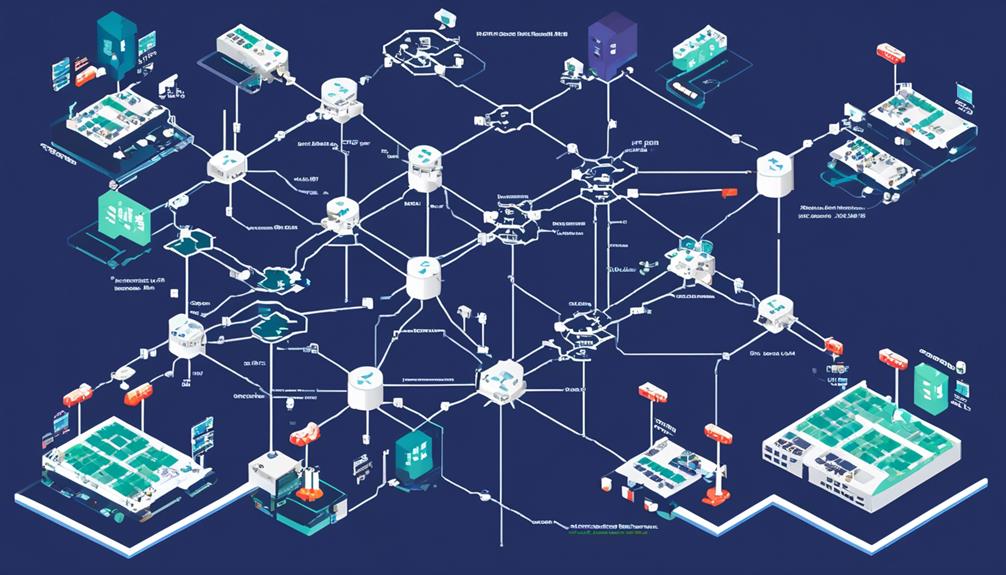In the ever-evolving world of networking, advanced routing techniques play a vital role in ensuring efficient and reliable communication between devices. These techniques encompass a range of strategies, from route advertisement and redistribution to the optimization of network performance and the implementation of multiple routing protocols.
By delving into the intricacies of advanced routing, network administrators can gain a deeper understanding of how to control routes, filter and redistribute them, and select the most suitable routing protocols for their specific needs.
In this discussion, we will explore the various aspects of advanced routing techniques, including routing basics, dynamic and static routing, routing policies, optimization techniques, troubleshooting, security best practices, and future trends in routing technologies.
So, let us embark on this journey into the world of advanced routing, where every twist and turn brings us closer to unlocking the secrets of an efficient and robust network infrastructure.
Key Takeaways
- Routing protocols like OSPF and BGP determine the best path for data packets based on metrics like hop count and bandwidth.
- Dynamic routing protocols like OSPF and EIGRP continuously exchange information with other routers to adapt to network changes and optimize performance.
- Static routing involves manually configuring the routing table on a network device and is useful for small networks with a limited number of predetermined routes.
- Investing in advanced routing hardware is integral for maintaining a high-performing network infrastructure.
Routing Basics

Routing Basics encompass fundamental concepts that are essential for understanding network communication and data transmission. Routing is the process of directing data packets from their source to their destination across a network. It involves determining the most efficient path for data packets to travel, based on factors such as network topology, traffic load, and administrative preferences.
Routing protocols play a crucial role in routing basics. These protocols enable routers to exchange routing information and build accurate routing tables. Routing protocols, such as OSPF (Open Shortest Path First) and BGP (Border Gateway Protocol), determine the best path for data packets based on metrics like hop count, bandwidth, and delay. They ensure that data packets are directed along the most efficient routes to reach their intended destinations.
Routing information is exchanged between routers through various mechanisms. Routers use routing protocols to share routing updates and maintain consistent routing tables. These updates contain information about network addresses, network reachability, and the cost associated with reaching different destinations. By exchanging routing information, routers can dynamically adapt to network changes and reroute data packets as necessary.
Understanding routing basics also involves the implementation of route filtering and route redistribution. Route filtering allows network administrators to control and restrict the flow of routing information between routers. This can help prevent the propagation of incorrect or malicious routing information. Route redistribution, on the other hand, enables routers to exchange routing information between different routing domains or protocols, allowing for connectivity between heterogeneous networks.
Advanced Routing Hardware
Advanced Routing Hardware plays a critical role in ensuring efficient and reliable network communication. High-performance routing devices equipped with cutting-edge router technology are essential for handling the increasing demands of modern networks.
These advanced devices enable sophisticated route control, allowing for precise path selection, efficient route advertisement, and the implementation of multiple routing protocols.
High-Performance Routing Devices
High-performance routing devices, designed with advanced hardware components, are essential for efficiently handling large volumes of network traffic in complex network environments. These devices incorporate high-speed processors and specialized network interface cards to ensure optimal performance.
By implementing complex routing protocols and making real-time routing decisions, these devices can optimize network performance. They play a crucial role in managing route advertisement, redistribution, and route filtering in complex network environments.
Additionally, advanced routing hardware is vital for organizations to ensure optimal application performance, workload management, and align network design with service goals. Without high-performance routing devices, organizations may experience network congestion, latency, and reduced overall efficiency.
Therefore, investing in advanced routing hardware is integral for organizations seeking to maintain a high-performing network infrastructure.
Cutting-Edge Router Technology
To ensure optimal network performance in complex environments, organizations rely on cutting-edge router technology that leverages advanced hardware components and sophisticated routing protocols. Advanced router technology involves controlling routes through route advertisement or redistribution, choosing specific paths for routing, and implementing multiple routing protocols. It focuses on optimizing network performance by reducing excessive routing updates and avoiding suboptimal paths. Moreover, it involves managing resources across complex IT environments for optimal application performance and workload management. By understanding the purpose and goals of the network, organizations can design and implement advanced routing algorithms that contribute to network performance optimization. This cutting-edge router technology enables organizations to achieve efficient and reliable data transmission, seamless connectivity, and improved overall network performance.
| Advanced router technology | Sophisticated routing protocols | Network performance optimization |
| Control routes through route advertisement or redistribution | Choose specific paths for routing | Reduce excessive routing updates |
| Implement multiple routing protocols | Avoid suboptimal paths | Manage resources for optimal application performance |
| Leverage advanced hardware components | Improve overall network performance | Achieve efficient and reliable data transmission |
| Ensure seamless connectivity | Optimize workload management |
Dynamic Routing Protocols

Dynamic routing protocols play a crucial role in enabling routers to automatically update and share routing information within a network. These protocols are essential for ensuring efficient network optimization and adaptability to changes in network topology. Examples of dynamic routing protocols include OSPF (Open Shortest Path First) and EIGRP (Enhanced Interior Gateway Routing Protocol).
Dynamic routing protocols utilize a variety of algorithms to exchange routing updates and determine the best path for forwarding data packets. By continuously exchanging information with other routers, these protocols dynamically learn about network changes such as link failures and adjust the routing tables accordingly. This automatic adaptation helps to optimize network performance by rerouting traffic through alternative paths in case of link failures.
Moreover, dynamic routing protocols are particularly useful in large and complex networks, where manually configuring static routes would be impractical. With dynamic routing protocols, network administrators can rely on the routers to autonomously exchange information and update their routing tables based on the latest network conditions. This reduces the administrative overhead and ensures that the network is always operating with the most up-to-date and efficient routing paths.
Static Routing Techniques
Static routing techniques involve manually configuring the routing table on a network device to determine the specific paths for directing traffic, serving as an alternative approach to dynamic routing protocols. Unlike dynamic routing protocols that automatically update routing tables based on network changes, static routing requires network administrators to manually define the routes. This technique is particularly useful for small networks with a limited number of predefined paths and stable network topologies.
One of the main benefits of static routing is the control it provides over the flow of traffic. By specifying the next hop for packets, network administrators can determine the exact path that traffic should take. This level of control helps optimize network performance and ensure efficient use of network resources. Additionally, static routes can enhance network security by allowing administrators to specify secure gateways for traffic.
Compared to dynamic routing protocols, static routing is simpler to configure and requires less overhead in terms of network traffic. Since static routes do not rely on periodic updates or exchanges of routing information, they are less susceptible to network congestion or instability. Furthermore, static routing can be more reliable in certain scenarios, such as when connecting remote networks over low-bandwidth or unstable connections.
Implementing static routing techniques requires careful planning and maintenance to ensure efficient and reliable network communication. Network administrators must manually configure and update routing tables as network changes occur. This includes adding or removing routes, modifying next hop addresses, or adjusting routing metrics. Regular monitoring and auditing of static routes are also essential to identify and resolve any potential issues that may arise.
Routing Policies and Access Control

Routing policies and access control mechanisms play a crucial role in effectively managing the flow of routing information within a network, ensuring efficient traffic management and enhancing network security. By implementing access control mechanisms, network administrators can regulate the paths through which data can travel within a network, preventing unauthorized access and potential security breaches.
Routing policy optimization allows administrators to control the routing paths within their network infrastructure to improve performance and reliability. This optimization involves strategically configuring route advertisement and redistribution, prioritizing certain paths, and optimizing the routing paths within the network. As a result, network performance is enhanced, reducing latency and improving overall network efficiency.
Furthermore, routing policy optimization also contributes to improved network resilience. By implementing multiple routing protocols, administrators provide greater flexibility and resilience. In the event of a failure or congestion, the network can adapt and reroute traffic through alternate paths, ensuring uninterrupted connectivity and maintaining network reliability.
Access control mechanisms and route filtering techniques are equally important in network management and security. These mechanisms and techniques enhance network security by preventing unauthorized access and ensuring that data flows through secure paths. By carefully controlling the flow of routing information through route filtering techniques, administrators can prevent the propagation of incorrect or malicious routing updates.
Additionally, access control mechanisms and route filtering techniques are essential for the seamless integration of networks. Careful route filtering and redistribution planning are crucial to prevent routing loops and ensure the seamless integration of different networks and protocols. This allows for efficient communication between network domains and facilitates the exchange of routing information, ultimately contributing to a more integrated and cohesive network infrastructure.
Load Balancing and Routing
To effectively manage network traffic and optimize resource utilization, load balancing techniques are employed in conjunction with routing strategies. Load balancing algorithms and traffic distribution techniques play a crucial role in achieving this goal.
Load balancing algorithms are responsible for distributing incoming network traffic across multiple paths, ensuring even distribution and preventing congestion. These algorithms consider factors such as the current load on each path, available bandwidth, and network latency to determine the best path for traffic distribution.
Traffic distribution techniques complement load balancing algorithms by providing mechanisms to distribute traffic based on specific criteria. For example, Equal-Cost Multi-Path (ECMP) routing distributes traffic equally across multiple paths with the same cost. This technique is commonly used in networks that support high availability and redundancy.
Route selection strategies also play a vital role in load balancing and routing. Different routing protocols and policies are used to determine the best path for network traffic. Factors such as the cost of the path, network topology, and network metrics are considered during route selection. By carefully selecting routes, network administrators can optimize resource utilization and ensure efficient traffic distribution.
It is important to note that load balancing and routing are closely intertwined processes. Load balancing techniques rely on routing protocols and mechanisms to determine the available paths for traffic distribution. Similarly, routing strategies depend on load balancing techniques to effectively distribute traffic across these paths.
Route Redistribution Techniques

The process of route redistribution involves the exchange of routing information between different routing protocols in a network. It plays a crucial role in integrating different routing protocols and ensuring efficient and effective routing. However, route redistribution can present several challenges that network administrators must address to maintain the stability and reliability of the network.
Route Redistribution Challenges:
- Routing Loops: One of the main challenges of route redistribution is the potential for routing loops. When routes are redistributed between protocols, it is essential to implement mechanisms or techniques that prevent loops from occurring. This can be achieved through the use of route filters or route-maps to control the flow of routing information.
- Protocol Mismatch: Route redistribution becomes complex when there is a mismatch between routing protocols. Different protocols have varying characteristics, such as administrative distances and metrics. Administrators must carefully choose the appropriate routing protocols and understand their characteristics to ensure smooth redistribution.
Route Redistribution Best Practices:
- Planning and Testing: Before implementing route redistribution, thorough planning and testing are crucial. Administrators should carefully analyze the network requirements and design a redistribution strategy that aligns with those requirements. Additionally, conducting extensive testing in a lab environment helps identify potential issues and ensures a smooth transition.
- Filtering and Summarization: Implementing route filters and summarization techniques can help manage the flow of routing information and optimize network performance. Filtering allows administrators to control which routes are redistributed, while summarization reduces the number of routes and improves scalability.
Route Redistribution Case Studies:
- Case Study 1: In a large enterprise network, route redistribution was implemented to integrate OSPF and EIGRP routing protocols. Careful planning and testing were conducted to avoid routing loops and ensure optimal path selection.
- Case Study 2: In a service provider network, route redistribution was employed to integrate BGP and OSPF. Filtering techniques were used to control the flow of routing information, ensuring only necessary routes were redistributed.
Advanced Routing Metrics
Advanced routing metrics play a crucial role in optimizing network performance and facilitating efficient route advertisement and redistribution. These metrics are essential for route selection, path optimization, and ensuring protocol compatibility in complex network environments.
Route selection is a critical aspect of advanced routing metrics. By assigning specific metrics to different routes, network administrators can control the path a packet takes through the network. Metrics such as hop count, bandwidth, delay, and reliability are commonly used to determine the best path for forwarding packets. For example, a network administrator may assign a higher metric to a slower, less reliable link to avoid excessive traffic congestion.
Path optimization is another key function of advanced routing metrics. By analyzing various metrics, network devices can dynamically adjust the routing path to optimize performance. For instance, if a high-bandwidth link becomes congested, the routing metric can reassign traffic to a less congested link, ensuring better overall network performance.
Protocol compatibility is also a crucial consideration when using advanced routing metrics. Different routing protocols may use different metrics, making it necessary to translate between them for effective route advertisement and redistribution. Network administrators must carefully plan and configure routing protocols to ensure compatibility and avoid suboptimal routing decisions.
Understanding the impact of excessive routing updates, running multiple protocols, and route filtering is vital when implementing advanced routing metrics. Excessive updates can consume network resources and cause unnecessary traffic. Running multiple protocols can lead to suboptimal paths and increased complexity. Route filtering helps control the routes that are advertised and redistributed, ensuring that only relevant and desired routes are propagated throughout the network.
Routing Optimization Techniques

Routing optimization techniques involve implementing strategies to enhance network performance and efficiency through the control of routes, utilization of multiple routing protocols, and reduction of excessive routing updates. By reducing updates, network administrators can minimize the overhead associated with routing protocol messages, leading to improved network scalability and responsiveness. This optimization technique ensures that only necessary routing updates are propagated, avoiding unnecessary network traffic and reducing the burden on routers.
Another aspect of routing optimization is avoiding suboptimal paths caused by running multiple protocols. When multiple routing protocols are used, there is a possibility of suboptimal routing decisions due to the different metrics and algorithms employed by each protocol. To address this challenge, network administrators can implement techniques such as route redistribution and route filtering. By carefully configuring route redistribution, administrators can control how routes are exchanged between different routing protocols, ensuring the selection of the most optimal path.
Route filters, another important optimization technique, can be used to control the flow of routing information. These filters allow network administrators to define specific criteria for accepting or rejecting routes, enhancing network security and performance. By implementing route filters, administrators can prevent the propagation of unauthorized or misleading routing information, improving network stability and reducing the risk of network attacks.
Troubleshooting Routing Issues
When troubleshooting routing issues, it is important to be aware of common problems that can occur, such as:
- Route advertisement issues
- Redistribution issues
Diagnostic tools play a crucial role in identifying and resolving these issues. They allow network administrators to:
- Analyze routing protocols
- Identify misconfigurations
- Pinpoint connectivity problems
Resolving routing issues often involves implementing proper route filtering techniques. This helps control the flow of routing information and ensures efficient route redistribution between different protocols.
Common Routing Problems
Identifying and resolving common problems in route advertisement and redistribution is crucial in troubleshooting routing issues.
When it comes to route advertisement, issues can arise due to misconfigured or missing route filters. These filters play a vital role in controlling the flow of routing information and ensuring network security.
Improper configuration can result in the advertisement of incorrect routes, leading to suboptimal network performance and potential security vulnerabilities.
On the other hand, network performance optimization is another area where problems can occur. Excessive routing updates can negatively impact network performance, causing congestion and increased latency.
Troubleshooting such issues requires analyzing routing protocols and fine-tuning parameters to minimize unnecessary updates.
Diagnostic Tools for Troubleshooting
Diagnostic tools play a crucial role in troubleshooting routing issues by providing network administrators with the necessary information to identify and resolve problems efficiently.
Traceroute analysis is one such tool that helps identify the path taken by packets to reach their destination, highlighting any routing issues along the way.
Ping troubleshooting is another commonly used tool that checks the connectivity between devices and can help identify routing problems if packets are not reaching their intended destination.
Additionally, Wireshark packet capture allows administrators to analyze network traffic and identify any routing problems by examining the packet headers and data.
Resolving Routing Issues
To effectively resolve routing issues, network administrators must implement strategies for controlling route advertisement and redistribution, selecting appropriate routing protocols, and optimizing network performance.
When troubleshooting routing issues, route analysis plays a crucial role in identifying and resolving problems. By analyzing the routing tables and examining the path taken by packets, administrators can pinpoint areas of concern, such as routing loops or suboptimal paths.
Additionally, route summarization can be employed to reduce the size of routing tables and improve scalability. This technique involves aggregating multiple routes into a single summarized route, resulting in a more efficient routing infrastructure.
Routing Security Best Practices
Securing the routing infrastructure requires implementing a robust set of best practices to protect against potential threats and vulnerabilities. Routing security measures play a crucial role in preventing route leaks and ensuring the integrity of the Border Gateway Protocol (BGP) and other routing protocols.
One important aspect of routing security is the implementation of route filtering. By carefully configuring route filters, network administrators can control the flow of routing information and prevent the propagation of unauthorized or malicious routes. Proper planning and regular updates to route filters are essential to avoid routing issues and maintain a secure routing infrastructure.
Another key consideration is the use of BGP security techniques. BGP is a critical routing protocol used to exchange routing information between autonomous systems. However, it is vulnerable to various attacks, such as route hijacking and spoofing. Implementing techniques like route origin validation (ROV) and BGPsec can help mitigate these risks by verifying the legitimacy of route announcements and ensuring the authenticity of routing information.
In addition to these measures, network administrators should also consider implementing secure routing protocols, such as Open Shortest Path First (OSPF) with IPsec or Routing Protocol Authentication (RPA). These protocols provide mechanisms for authentication and encryption, protecting routing information from unauthorized access and tampering.
Regular monitoring and auditing of routing infrastructure is also crucial for detecting and responding to any security incidents promptly. By analyzing routing logs and monitoring route announcements, administrators can identify anomalies and take appropriate action to mitigate potential threats.
Future Trends in Routing Technologies

The future of routing technologies is marked by advancements in machine learning, AI integration, and the adoption of segment routing for more efficient traffic engineering in large-scale networks. These trends are driven by the need for improved network performance, scalability, and flexibility.
- Machine learning in routing: Machine learning techniques are being applied to routing algorithms to optimize routing decisions and adapt to changing network conditions in real-time. By analyzing historical network data and patterns, machine learning algorithms can predict traffic flows and make intelligent routing decisions to minimize latency and maximize throughput.
- SDN in routing strategies: Software-Defined Networking (SDN) is becoming increasingly important in future routing strategies. SDN separates the control plane from the data plane, allowing for centralized network management and programmability. This enables dynamic routing decisions based on real-time network conditions and application requirements, leading to more efficient and adaptive routing strategies.
- IPv6 impact on routing: The emergence of IPv6 and its impact on routing protocols and address allocation is another significant trend in routing technologies. IPv6 offers a larger address space and improved security features compared to IPv4. However, the transition to IPv6 requires updates to routing protocols and infrastructure to support the new addressing scheme effectively.
These future trends in routing technologies are driven by the need for more intelligent, scalable, and flexible networks. Machine learning and AI integration in routing algorithms enable more efficient traffic engineering and adaptive routing decisions. SDN provides centralized management and programmability for dynamic routing strategies. The transition to IPv6 brings significant changes to routing protocols and address allocation. As networks continue to evolve, these trends will shape the future of routing technologies, enabling more robust and efficient network operations.
Frequently Asked Questions
What Are the Advanced Routing Capabilities?
Advanced routing capabilities encompass dynamic routing, policy-based routing, and load balancing.
Dynamic routing allows routers to automatically exchange routing information and adapt to changes in network topology.
Policy-based routing enables network administrators to define rules for routing traffic based on specific criteria such as source IP address or application type.
Load balancing distributes network traffic across multiple paths to optimize resource utilization and improve performance.
These advanced techniques provide greater flexibility, control, and efficiency in managing network routing.
What Is Routing Techniques?
Routing techniques refer to the strategies and methods employed to control the flow of network traffic through the selection and configuration of routes. These techniques encompass various aspects such as network segmentation, load balancing, and quality of service (QoS).
Network segmentation involves dividing a network into smaller, isolated segments to enhance security and manage traffic efficiently.
Load balancing distributes network traffic evenly across multiple paths to optimize performance.
Quality of service ensures the prioritization of specific types of traffic to meet performance requirements.
What Is Advanced Routing in Palo Alto?
Advanced routing in Palo Alto refers to the advanced routing features available in Palo Alto Networks' firewall solutions. It enables network administrators to have more control over route advertisement and redistribution, choose specific paths for routing, and implement multiple routing protocols.
This advanced routing capability brings several benefits to network management, including enhanced network performance, reduced routing updates, avoidance of suboptimal paths, and improved network security through route filtering.
Implementing advanced routing in Palo Alto requires proper planning, configuration, and selecting the appropriate routing protocol based on network requirements, scalability, convergence speed, and resource utilization.
What Is the Routing Protocol Technique?
A routing protocol technique refers to the methods and procedures used to determine the optimal paths for data transmission in a network. It involves the use of dynamic routing protocols that exchange information about available routes and update the routing table accordingly.
These protocols enable routers to select the most efficient paths based on factors such as network congestion, link quality, and cost. The routing table contains this information and is used by routers to make forwarding decisions, ensuring effective and efficient data transmission within the network.
